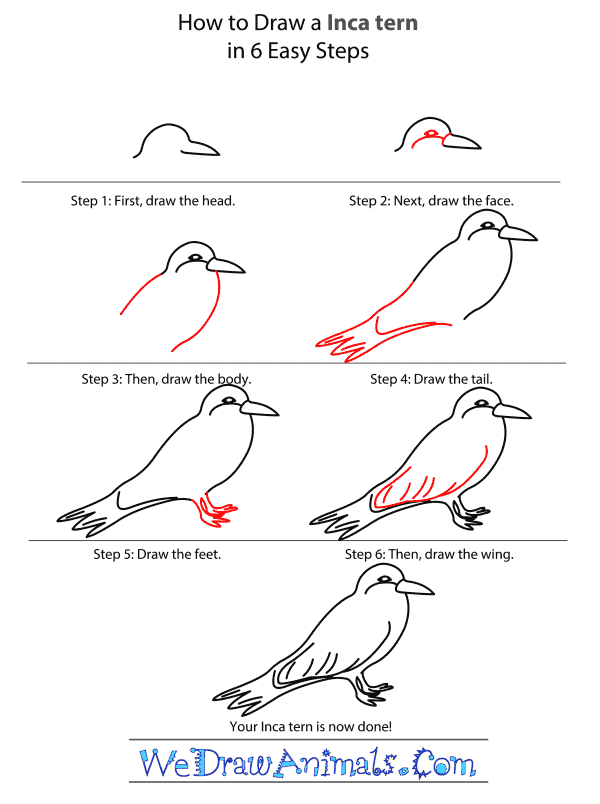In this quick tutorial you'll learn how to draw an Inca Tern in 6 easy steps - great for kids and novice artists.
The images above represent how your finished drawing is going to look and the steps involved.
Below are the individual steps - you can click on each one for a High Resolution printable PDF version.
At the bottom you can read some interesting facts about the Inca Tern.
Make sure you also check out any of the hundreds of drawing tutorials grouped by category.
How to Draw an Inca Tern - Step-by-Step Tutorial
Step 1: To draw the head, start with a line from the left that curves around and ends in a pointed beak.
Step 2: Draw an oval-shaped eyes with an empty white space for the eye. Add a line to separate the beak from the face and a line down the face near the eye
Step 3: Draw a long and narrow body by drawing two lines, one curved and the other straight
Step 4: Draw a tail by adding onto the body. Use lines to add feathers.
Step 5: Add feet. Remember that birds' feet are a little strange and narrow.
Step 6: Finally, add detail to the body by adding lines for feathers.
Interesting Facts about the Inca Tern
The Inca tern is found on the Pacific coast of South America. This is a slender bird with mostly black feathers. It has a characteristic white feather that curls from its beak to its neck, resembling a moustache. Furthermore, it has a bright red bill and legs. They are carnivores that mainly eat fish. They eat by plunge diving into the water to catch fish close to the water’s surface. Inca terns breed on rocky coastal cliffs or inshore islands. They place their nests in burrows or caves. Females lay one or two eggs and incubated them for about four weeks. Inca tern chicks leave their nests after about seven weeks. Adults weigh from 6 to 7.5 ounces and grow from 16 to 22 inches in length.
Did you know?
- Loss of nesting habitat is a threat to the Inca tern.
- The presence of cats and rats reduces the success rate of breeding in Inca terns.
- This species is in the Order Charadriiformes and the Family Sternidae.
- Large flocks of 100 or more birds have been observed following fishing fleets to feed on the bi-catch and fish scraps.
- The sea lion is one of their predators.
Lesson plan note: Draw a large picture of the Inca tern. Make copies and distribute to each child. Have the children use markers, crayons, or colored pencils to color their bird. Write the name of each child on the back of their bird. Then, hang each Inca tern on the bulletin board for everyone to see.







